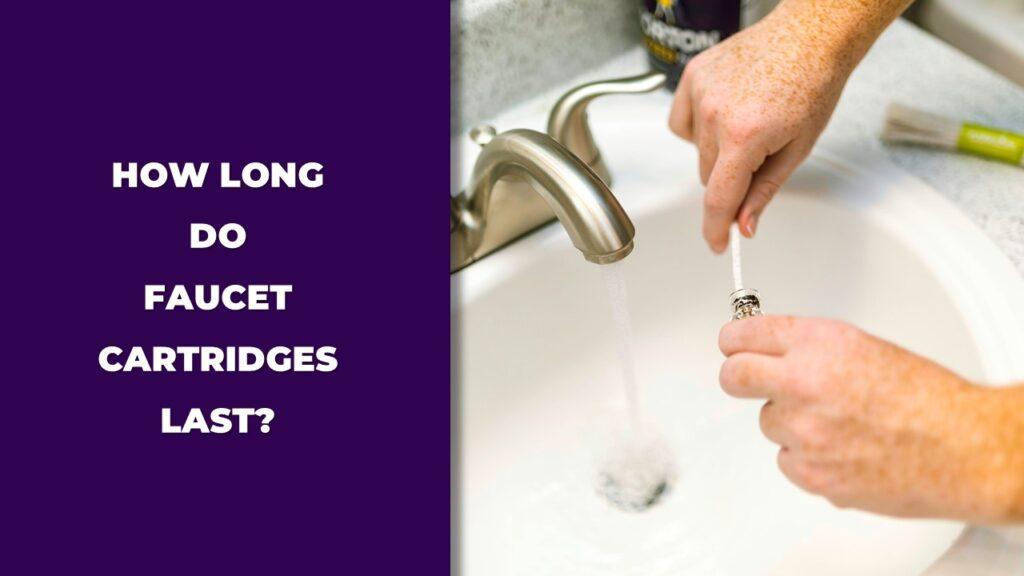
Faucet cartridges usually last 10 to 20 years, but that can change based on how often you use the faucet, the type of cartridge, and the quality of your water. The cartridge controls the flow and temperature of water. Over time, it wears out, especially if you have hard water or use the faucet daily. That’s when leaks, pressure problems, or a sticky handle show up.
In this article, we’ll explain the different cartridge types, what affects their lifespan, signs it’s time for a replacement, and how to do the job yourself, as well as simple tips to help you keep your faucet working like new.
What Is a Faucet Cartridge?
A faucet cartridge is the small part inside your faucet that controls how much water flows out, how hot or cold it is, and how smooth the handle feels when you turn it. Think of it like a traffic cop, directing water exactly where it needs to go.
Cartridges come in different styles, like ceramic, brass, or plastic. Each one works a little differently, and some models, like those you’ll find in high-end kitchen faucets. use top-quality cartridges for smoother performance and a longer lifespan. But they all have the same job: making sure your faucet turns on, off, and adjusts smoothly. If your faucet starts leaking or the handle feels stiff, there’s a good chance the cartridge is the problem. It’s the part that keeps things running quietly, until it doesn’t.
How Long Do Faucet Cartridges Usually Last?
Faucet cartridges usually last 10 to 20 years, but that can change based on how often you use the faucet, the type of cartridge, and the quality of your water. In homes where hard water is a problem, as is often seen in kitchen faucets for hard water, the minerals in the water can wear out cartridges much faster.
Let’s break down what to expect based on different cartridge types, what can shorten the lifespan, and the early signs that something’s going wrong.
Quick Table: Cartridge Lifespan by Type
Here’s a quick guide to how long different faucet cartridges last:
| Cartridge Type | Average Lifespan | Notes |
| Ceramic Disc | 15–25 years | Long-lasting, handles wear well |
| Brass | 10–15 years | Solid, but can corrode over time |
| Plastic | 5–10 years | Wears out faster, cracks easily |
| Ball-Type | 8–12 years | Can leak with hard water buildup |
| Thermostatic | 8–15 years | Needs clean water to last |
Factors That Shorten Lifespan
What wears out a faucet cartridge? Here’s what makes a difference:
- Hard Water: Minerals build up inside, making the cartridge stiff or clogged.
- Frequent Use: Daily kitchen sink? That’s hard on a cartridge.
- Low-Quality Parts: A cheap cartridge will wear out sooner.
- Wrong Fit: If it’s not installed right, it can leak or get damaged fast.
- Skipping Maintenance: Letting leaks go? That makes the problem worse.
Even small issues, like a loose handle or a slow drip, can wear out the cartridge faster.
Signs of Early Failure
Wondering if your cartridge is wearing out? Here’s what to watch for:
- A Drip That Won’t Quit: Water keeps coming even when the faucet is off.
- Weak Water Flow: The faucet feels like it’s gasping for water.
- A Handle That’s Hard to Turn: Or worse, one that feels wobbly or stuck.
- Hot Water in the Cold Side: Or the other way around. That’s a sign of a cartridge issue.
- Weird Noises: Whistling or humming sounds when you turn the water on.
If these sound familiar, your faucet might be trying to tell you the cartridge is on its way out.
Factors That Affect Faucet Cartridge Lifespan
Faucet cartridges usually last 10 to 20 years, but that’s just a rough estimate. The truth is, how long a faucet cartridge lasts depends on a few key things. Some folks barely think about their faucet for 15 years, while others end up replacing the cartridge way sooner.
Here’s what really affects how long a faucet cartridge lasts:
- Water Quality: Hard water is a big troublemaker. It leaves behind minerals that build up inside the cartridge, making it stick, leak, or wear out sooner than it should. If your area has hard water, expect to replace a faucet cartridge more often.
- Faucet Type: Not all faucets get the same use. A kitchen faucet that sees action all day will wear out faster than a bathroom faucet in the guest room. Mixer taps and fancy faucets with extra features tend to wear cartridges down quicker too.
- Material and Build Quality: Not all cartridges are built the same. A solid ceramic cartridge can go the distance, while a cheap plastic one might not last half as long. If your faucet came with a lower-quality cartridge, it may not hold up well over time.
- Usage Patterns: If your faucet gets used every day, especially in busy areas like the kitchen, the cartridge will wear out faster. The more you turn the handle, the more wear you put on that little part inside.
- Maintenance Habits: A little care makes a big difference. Regularly cleaning the faucet and handling small leaks early can keep a cartridge working for years. Ignoring drips or letting minerals build up? That’s a fast track to a worn-out cartridge.
How to Tell If a Faucet Cartridge Needs Replacing
A faucet cartridge usually needs replacing when you start noticing small but annoying problems. It might be a slow drip that won’t stop, a handle that’s hard to move, or water pressure that seems weaker than usual. Catching these signs early can save you a lot of hassle.
Here’s what to watch for:
Common Symptoms
These are the signs most people notice first:
- Leaking or Dripping: The faucet drips even when it’s off.
- Low Water Pressure: The water comes out weaker than it used to.
- Handle Problems: The handle feels stiff, wobbly, or doesn’t turn like it should.
- Temperature Issues: Hot water when you expect cold, or the other way around.
- Noisy Operation: Whistling, humming, or a slight vibration sound when the water runs.
Hidden Issues
Some problems hide a bit deeper:
- Internal Leaks: Water sneaks past the cartridge and slowly leaks under the sink.
- Corrosion or Scale Buildup: Hard water eats away at the cartridge from the inside out.
- Uneven Wear: The cartridge wears down on one side, making the handle feel off.
Quick DIY Check
Want to do a fast check without taking the faucet apart?
- Turn off the water and gently move the handle. If it feels sticky, loose, or off, the cartridge might be wearing out.
- Check for water seeping out around the handle or base. That’s a red flag for cartridge trouble.
- If you’re comfortable, remove the handle and peek inside. Any signs of rust, scale, or cracks? That’s a clear sign the cartridge is ready for a swap.
Should You Replace the Cartridge or the Entire Faucet?
If your faucet is dripping or the handle feels stuck, most of the time you just need to replace the cartridge. But sometimes, it’s smarter to replace the whole faucet—especially if it’s old or giving you problems left and right.
Here’s how to figure out what makes sense:
When to Replace the Cartridge
- The faucet is less than 10 to 15 years old.
- The faucet body is in good shape, no rust no corrosion.
- You’re only dealing with leaks, a stiff handle, or low pressure.
- You can find the right replacement cartridge for your faucet model.
When to Replace the Entire Faucet
- The faucet is over 15 to 20 years old and has seen better days.
- Multiple parts are failing, maybe the spout leaks, the handles feel loose, and the finish is wearing off.
- You want to update the look or improve water efficiency.
- The finish is scratched, faded, or peeling, and it’s just not worth fixing anymore.
Cost Considerations
Replacing a faucet cartridge usually costs between $10 and $80 for the part. If you’re doing it yourself, that might be all you pay. If you hire a plumber, you’ll need to add their labor fee, which can vary.
A new faucet can cost anywhere from $150 to $500 or more, depending on the style and brand.
If your faucet is still in good shape and it’s just a leak or a sticky handle, go ahead and replace the cartridge. It’s usually the easiest and most budget-friendly fix. But if the faucet is old, worn, or giving you constant trouble, replacing the whole faucet might save you time and headaches down the road.
How to Replace a Faucet Cartridge (Step-by-Step DIY Guide)
Replacing a faucet cartridge might sound tricky, but it’s actually a task you can handle with a little patience and the right tools. If your faucet is leaking, the handle feels stiff, or the water isn’t flowing right, this is often the fix.
Here’s how to tackle it without turning your sink into a disaster zone:
Before You Start
- Shut off the water supply under the sink. You don’t want water gushing everywhere.
- Plug the drain. Small screws or parts can fall right in, and trust me, fishing them out is a pain.
- Gather your tools: An adjustable wrench, a screwdriver, pliers, a towel, and a replacement cartridge (match the model carefully).
Step-by-Step Process
Here are step-by-step processes that you can follow to replace a faucet cartridge:
- Turn off the water at the shut-off valves.
- Remove the faucet handle. Look for a small screw under a cap or behind the handle.
- Take off any decorative covers or sleeves.
- Unscrew the retaining nut that holds the cartridge in place.
- Gently pull out the old cartridge. If it’s stuck, wiggle it or use pliers.
- Clean the valve body with a soft cloth to remove any buildup or gunk.
- Insert the new cartridge, lining it up just like the old one.
- Reassemble the faucet—handle, screws, and any covers.
- Turn the water back on slowly and check for leaks.
Pro Tips
- If the cartridge won’t budge, try soaking the area with white vinegar to break down mineral deposits.
- Always take the old cartridge to the store when buying a new one—it helps you get the exact match.
- Don’t over-tighten the retaining nut. Just snug enough to hold the cartridge in place.
- A little plumber’s grease on O-rings can help the handle turn smoothly.
When to Call a Plumber
You can do a lot with DIY, but sometimes, it’s just not worth the hassle. Call a plumber if:
- The cartridge is stuck, and you can’t get it out without forcing it.
- The faucet is leaking from multiple places or the base is corroded.
- You’ve replaced the cartridge, but the faucet still leaks.
- You’re unsure about the faucet model or the replacement cartridge.
- You don’t feel comfortable taking apart the faucet—no shame in that!
A professional can fix the problem quickly and save you from making it worse.
How to Extend the Lifespan of Your Faucet Cartridge (Expert Maintenance Tips)
Want your faucet cartridge to last as long as possible? It’s all about a little care now to avoid big problems later. Here’s what helps:
- Use a water softener if you live in a hard water area. It cuts down on mineral buildup that wears out cartridges.
- Clean the faucet aerator once or twice a year. It traps debris before it reaches the cartridge.
- Turn the handle gently. Slamming it back and forth can wear out the cartridge faster.
- Flush the lines occasionally by turning off the water, removing the aerator, and letting water flow full blast for a minute. This clears out grit that can damage the cartridge.
- Check for small leaks and handle them quickly. Don’t wait for a drip to turn into a flood.
A few minutes of care can add years to your cartridge’s lifespan.
Final Thoughts
Your faucet cartridge is a small part that does a big job. It controls the flow, temperature, and feel of your faucet, but it won’t last forever. Cartridges wear out, especially if you’ve got hard water or a faucet that gets a lot of use.
Take a few minutes every year to check on your faucet. Look for drips, leaks, or a handle that feels stiff. A little maintenance now means you’ll avoid bigger problems down the line.
Regular care helps you avoid leaks, save on water bills, and keep your faucet working smoothly for years.
Take action today, inspect, replace, and maintain your faucet cartridge so your sink stays drip-free and easy to use.
Related FAQs
How often should I replace a faucet cartridge?
You should replace a faucet cartridge every 10 to 20 years, depending on how often you use the faucet, water quality, and maintenance. If you notice leaks, pressure changes, or a sticky handle, it’s time to check the cartridge.
Does water hardness affect cartridge lifespan?
Yes, hard water can shorten the lifespan of a faucet cartridge. Minerals like calcium and lime build up inside, causing clogs, leaks, or stiffness. Using a water softener or regular cleaning helps prevent this.
Can a worn cartridge damage my faucet?
Yes, a worn cartridge can lead to leaks and internal damage in the faucet body. If left unchecked, this can cause corrosion, rust, or permanent wear inside the faucet, leading to bigger repairs later.
How do I identify the correct replacement cartridge?
The easiest way is to remove the old cartridge and take it with you to the hardware store. You can also check your faucet’s brand and model number, usually found under the sink or in the user manual.
Is replacing a faucet cartridge a DIY job or should I call a plumber?
Replacing a faucet cartridge is a DIY job for most people with basic tools and a little patience. But if the cartridge is stuck or you’re unsure of the faucet model, calling a plumber is a safe bet.
Why is my faucet still leaking after replacing the cartridge?
If your faucet still leaks after replacing the cartridge, check for worn O-rings, loose connections, or damage to the faucet body. Sometimes, a second issue is hiding behind the first.

Dylan Foster is a family man with years of hands-on experience in plumbing, household maintenance, and fixing everyday issues around the home. A former plumber, Dylan knows what it’s like to deal with tricky leaks, worn-out parts, and all the little problems that pop up in a house. From plumbing repairs to kitchen fixes and garden hose setups, he’s done it all. Dylan shares real-world solutions to help others keep their homes running smoothly and avoid costly mistakes.




